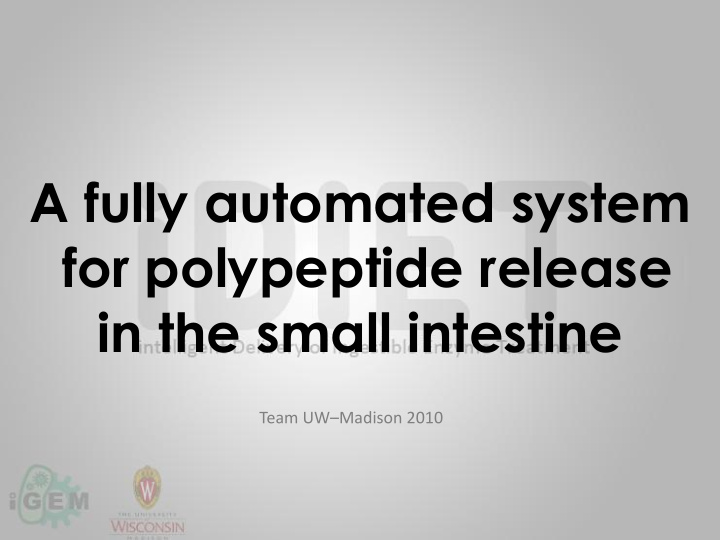



A fully automated system for polypeptide release in the small intestine Team UW – Madison 2010
iDIET in Brief Growth Growth Dietary Ingestion Dietary Ingestion Acid Survival Acid Survival Lysis & Lysis & Product Release Product Release Product Absorption Product Absorption
Genetic Disorders & More: Celiac Disease • 1 in 133 are diagnosed in the US • US healthcare cost: $14.5 - $34.8 billion annually • No cure • Extreme dietary measures
Genetic Disorders & More: High Cholesterol • Cholesterol made from bile acids • Bile Salt Hydrolase enzyme deconjugates • Deconjugates bile salts cannot be reused
Genetic Disorders & More: High Cholesterol Cholesterol Bile Salts Deconjugated Bile Salts Bile Salts
Genetic Disorders & More: High Cholesterol Serum Cholesterol Cholesterol Bile Salts Deconjugated Bile Salts Bile Salts Excreted
Genetic Disorders & More: Lactose Intolerance • Unable to digest lactose found in dairy products • Model system for experiment – Deliver beta-galactosidase by timed-lysis to small intestines – Interchangeable system
Growing Micro-Organisms
Growth: Encapsulation & Enzyme Production constitutive B-Gal B-Gal RcsA RcsA RcsB RcsB REPLACABLE REPLACABLE ENZYME ENZYME
Ingestion
Encapsulation Testing Constructs Constitutive B-Gal RcsA RcsB REPLACABLE ENZYME Testing Constructs IPTG Inducible RcsA RcsB RcsA RcsB
Encapsulation: Proof of Colonic Acid Production Colonic Acid
Encapsulation: Proof of Colonic Acid Production Quantification of L-Fucose 10 (ug/ml)/OD600 of L-Fucose 8 6 4 2 0 Control RcsB RcsA
Encapsulation: Cell Survivability in Low pH Cells Survivability at pH4 1.21E+12 CFU per ml 8.1E+11 4.1E+11 1E+10 RcsA RcsB RcsA+RcsB Control
Enzyme Release in Small Intestine 1) Inducible Repressible • pH promoter • Activator and Repressor • A promoter sensitive to activator and repressor 2) Bile Salt Inducible Expression • Salmonella enterica strain LT2 • PCR Amplify and clone ramA and acrRA genes 3) Encryption System • See our poster
Inducible-Repressible Lysis Before Duodenum of Stomach Stomach Small Intestine cI Low pH LuxR pH I/R cI + LVA cI + LVA LuxR LuxR Lysis Cassette Lysis Cassette
Inducible-Repressible Lysis: Testing Constructs gadAP I/R cI + LVA LuxR Lysis Cassette Testing Construct RFP
Protein expression behind the gadA promoter is dependant on growth phase gadAp RFP Expression vs Time and OD (pH 5.5) 12000 7 • Tight control of expression below OD 3.0 6 10000 (indistinguishable from baseline 5 fluorescence) 8000 5x RFU/OD 600 4 6000 • OD 600 Limited expression from OD 3.0 to OD 5.5 3 4000 2 • Induction as culture approaches a true 2000 1 stationary state 0 0 0 5 10 15 20 25 30 Time (hrs) gadAp + mRFP1, pSB1A2 MG1655 WT MG1655 placI + mRFP1, pSB1A2 MG1655
2. Bile Inducible Lysis: System Before Duodenum of Duodenum Small Intestine BS BS BS RamA BS AcrRA constitutive RamA Lysis Cassette Lysis Cassette
2. Bile Induced Lysis: Testing Constructs constitutive AcrRA RamA Lysis Cassette Testing Constructs AcrRA constitutive RamA RFP
Enzyme Action
Large Intestine
Large Intestine
Registry Maintenance: BBF RFC 67 EXPERIENCE GENBANK C 40 20 0 SEQUENCING TESTING
Achievements Registry Additions Registry Additions Lysis Systems in Small Intestine Lysis Systems in Small Intestine • • K318500 * K318507 1. Inducible-Repressible System • • K318501 * K318511 2. Induction in the presence of Bile • • K318502 * K318512 * 3. Encryption (see wiki/poster) • • K318506 K318513 * * Characterized Characterization Characterization Applications Applications 1. gadA promoter 1. More efficient delivery of functional • OD enzyme to the small intestine • pH 2. Decrease in cost of production and 2. Expression of RcsA, RcsB, RcsA&RcsB purification for pharmaceuticals • Colonic acid production 3. Accessibility of treatments for genetic • Cell survivability disorders
References IMAGES http://diet.lovetoknow.com/wiki/Lactose_Intolerance_Symptoms http://popsop.com/wp-content/uploads/realgoodness_blue.jpg http://topnews.in/health/files/heart-attacks_0.jpg http://media.photobucket.com/image/atherosclerosis/Kacchan_08/atherosclerosis-2.jpg BACKGROUND 1 Fasano A, Berti I, Gerarduzzi T, et al. Prevalence of celiac disease in at-risk and not-at-risk groups in the United States. Archives of Internal Medicine . 2003;163(3):268 – 292. Martini,M., G. Bollweg, M. Levitt, and D. Savaiano. 1987. Lactose Ingestion of yogurt β -galactosidase: influence of pH and microbial cell integrity. Am. J. Clin Nutr. 45:432-436. NICHD, NIH. 2006. Lactose Intolerance: Information for Health Care Providers. <http://www.nichd.nih.gov/publications/pubs/upload/NICHD_MM_Lactose_FS.pdf> NIDDK, NIH. 2009. Lactose Intolerance. <http://digestive.niddk.nih.gov/ddiseases/pubs/lactoseintolerance/> BILE INDUCTION Nikaido E., A. Yamaguchi, and K. Nishino. 2008. AcrAB Multidrug Efflux Pump Regulation in Salmonella enterica serovar Typhimurium by RamA in Response to Environmental Signals. J. Biol. Chem. 283:24245-24253. Liong, M.T. and N.P. Shah. 2005. Bile salt deconjugation ability, bile salt hydrolase activity and cholesterol co-precipitation ability of lactobacilli strains. Int. Dairy J. 15:391-398. INDUCIBLE/REPRESSIBLE Tucker, D., et al. Gene Expression Profiling of the pH Response in Escherichia coli. J Bacteriol. 2002. 184(23): 6551 – 6558. Waterman, S., et al. Transcriptional Expression of Escherichia coli Glutamate-Dependent Acid Resistance Genes gadA and gadBC in an hns rpoS Mutant. J Bacteriol. 2003. 185(15): 4644-4647. Castanie-Cornet, M., et al. Control of Acid Resistance in Escherichia coli. J Bacteriol. 1990. 181(11): 3525-3535.
Questions?
Recommend
More recommend